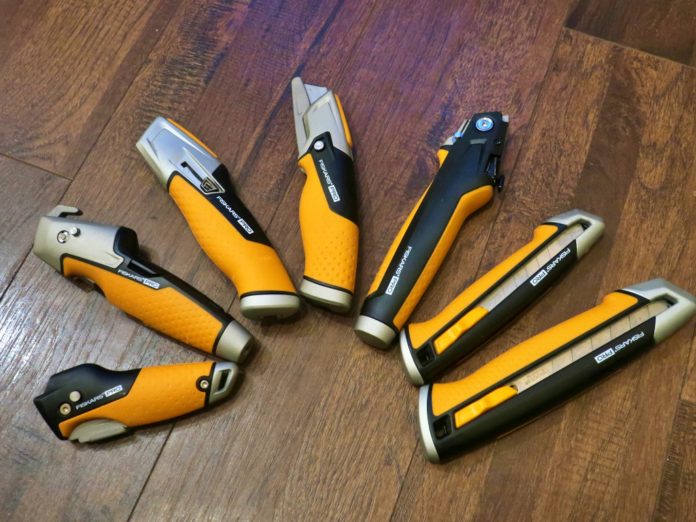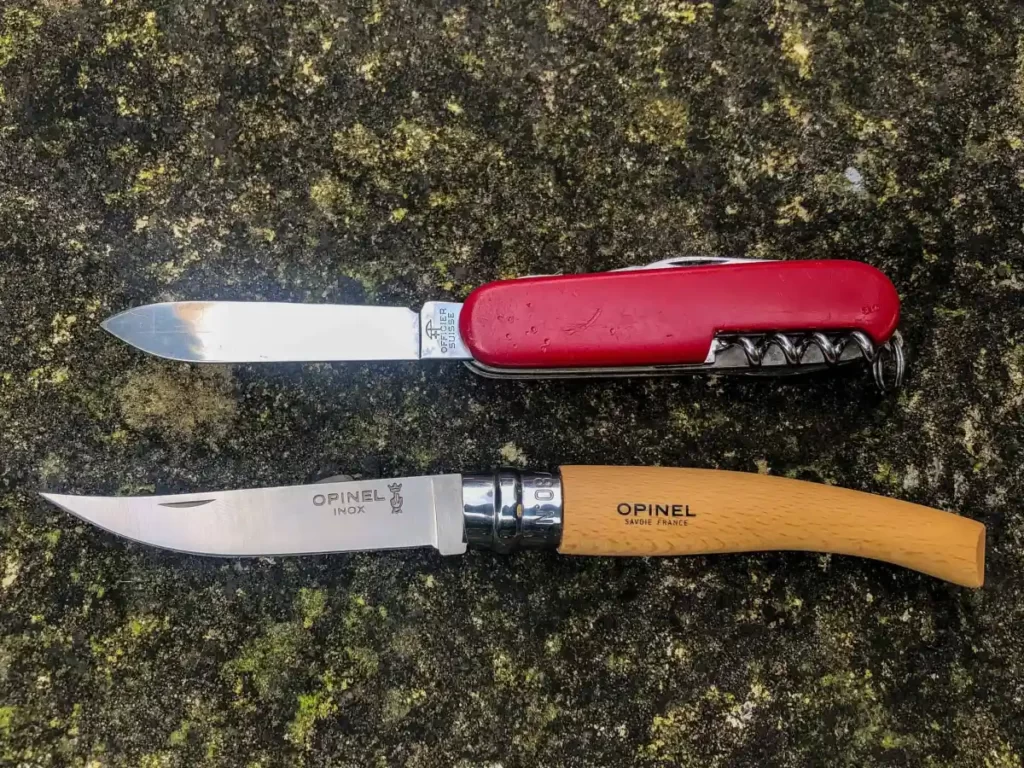Utility knives are essential cutting tools. Many families, workshops, and industries use these helpful items. Utility knives—what are they? This guide covers utility knives, their purposes, kinds, and safety. Let’s learn all about utility knives.
What is a Utility Knife?
Utility knives are designed to perform many different jobs. A box cutter or Stanley knife (called after the company) has a retractable blade in a handle.
For safe storage and easy use, the blade can be extended or retracted. Construction, crafts, packaging, and home duties use utility knives.
Different Types of Utility Knives

Utility knives are designed for different tasks. Common utility knives include:
Retractable Utility Knives: These knives allow the user to modify the blade length depending on the task. The retractable feature reduces accidents.
Fixed Blade Utility Knives: Fixed-blade utility knives feature an exposed blade, unlike retractable knives. These heavy-duty knives are stable and strong.
Snap-Off Blade Utility Knives: Replaceable blades can be snapped off when dull. This design maintains sharp edges without blade replacements.
Folding Utility Knives: Folding utility knives have a hinged blade that folds into the handle. Outdoor enthusiasts prefer it for its safety and portability.
Safety Utility Knives: Blade guards, automated blade retraction, and ergonomic handles ensure user safety. Safety-conscious industry employ these knives.
Specialty Utility Knives: For specific uses. Carpet knives have hooked blades for precise carpet cutting, while drywall knives have larger blades for efficient drywall cutting.
The History of Utility Knives
Utility knives have a rich history that spans millennia. Stone, bone, and obsidian were the earliest utility knives. Utility knives evolved with metal blades and sophisticated designs as civilization progressed.
Modern utility knives originated in the early 20th century. In 1930, Stanley Works, an esteemed American company, produced the “Stanley knife,” which rapidly won over many due to its functionality and versatility. Utility knives are now essential in many businesses and households worldwide.
Common Uses of Utility Knives

Utility knives are versatile and used in many tasks. Common utility knife uses:
Opening Packages: Utility knives cut through shrink wrap and cardboard boxes. Sharp blades cut package materials quickly.
Crafts and hobbies: Utility knives are essential for cutting paper and fabric and carving wood and plastic. They enable precise, controlled cutting.
Construction and DIY Projects: Utility knives are essential for construction and DIY operations. They can score drywall, trim insulation, cut ropes, and do other construction site cutting chores.
Camping and Outdoor Activities: Outdoor lovers use utility knives to cut rope, cook, and repair. Camping, trekking, and other outdoor activities are easier with their tiny size and versatility.
Gardening: Utility knives are useful for pruning stems, opening soil and fertilizer bags, and dividing plants. Their sharp blades provide precise cutting without hurting plants.
Emergency Situations: Utility knives are typically in emergency kits. In emergencies, they can cut seatbelts.
Safety Tips for Using Utility Knives

Utility knives are useful, but safety is paramount. Safety tips:
Choose the Right Knife: Pick a utility knife for the job. Choose a knife with a functional blade length and safety features.
Handle Carefully: Never touch a utility knife’s blade. Avoid holding the knife with your finger on the blade or blocking the cutting path.
Safety Features: Utility knives require a firm cutting surface and a clear line of sight. Allow the blade to cut with consistent pressure.
Sharpen Blades: Dull blades take more energy to cut, increasing the risk of slips and accidents. Maintain cutting performance by replacing or sharpening blades.
Store Safely: To avoid cuts, retract or sheath the blade after usage. Keep the utility knife away from youngsters and other tools that could damage it.
Dispose of Blades Properly: Never discard used utility knife blades in conventional trash bins where they could harm sanitation personnel. Dispose of them in a blade disposal container or with strong tape.
How to Choose the Right Utility Knife

Choosing a utility knife might be overwhelming with so many options. To decide, consider these factors:
Blade Type: Choose the right blade. Based on your tasks, consider blade length, material (carbon steel or stainless steel), and cutting edge design (straight, serrated, or hooked).
Handle Design: Utility knives should have ergonomic handles for a stable grip. Rubber or textured plastic handles improve grip and control.
Safety Features: Prioritize knives with blade locking or retractable systems. These prevent blade exposure and damage.
Durability and Build Quality: Choose robust utility knives for continuous use. Long-lasting stainless steel blades and strong handles.
Blade Replacement: Check the utility knife’s blade replacement and snapping ability. A tool-free blade replacement system or blade snapping mechanism saves time.
Budget: Choose a utility knife within a budget range. Quality and safety should trump price.
What Makes a Good Utility Knife?
Utility knife performance depends on several aspects. Consider these traits:
Sharpness: A good utility knife has a long-lasting sharp blade. Sharp blades cut cleanly and safely, preventing accidents from slippage.
Versatility: Choose a versatile utility knife. Knives with detachable blades or numerous cutting edges are versatile.
Durability: A sturdy utility knife performs well under heavy use. Durability depends on blade and handle materials.
Safety Features: Utility knives should prioritize safety. Blade locks, retractable mechanisms, and ergonomic handles avoid inadvertent cuts and provide a stable grip.
Comfort and Ergonomics: Utility knife ergonomics and comfort are important. Using a handle with curves and grip-enhancing materials reduces hand fatigue and improves control.
Use: A good utility knife should be easy to handle. Look for smooth blade deployment and retraction, easy blade changing, and user-friendly design.
Brand Reputation: Utility knife brands should be trusted. Tools from well-known companies are more likely to work well.
Maintenance and Care of Utility Knives
Utility knives need regular maintenance to last and perform well. Remember these tips:
Cleanliness: Clean your utility knife regularly to remove dirt and grime from the blade and handle. Before storing, lightly scrub surfaces with mild soap and water and dry.
Blade honing: Blades need periodic honing depending on use. Maintain sharpness using a utility knife sharpening stone or honing rod. Follow manufacturer sharpening instructions.
Blade Replacement: Replace worn blades. Replace blades safely by following the manufacturer’s recommendations.
Lubrication: Lightly oil the utility knife’s blade pivot point and other moving parts. This avoids rust and smooths operation.
Storage: Keep your utility knife dry and out of the elements. Use blade sheaths or protectors for storage.
FAQs
Utility knives for self-defense?
Utility knives are not designed for self-defense, even though they contain sharp blades. Prioritize safety and follow local self-defense laws.
Utility knives only cut?
Utility knives do more than cut. They are used for scraping, scoring, carving, and precision work in different sectors and hobbies.
Utility knives outdoors?
Utility knives are great for camping, trekking, and fishing. They can cut ropes, cook, and fix things.
How do utility and pocket knives differ?
Utility and pocket knives have various uses. Pocket knives can have scissors, screwdrivers, and bottle openers, whereas utility knives are for cutting.
Utility knives on planes?
Utility knives are not allowed on flights. For security, pack them in checked luggage.
Utility knife sharpening frequency?
How often you sharpen your utility knife depends on its use and tasks. When the blade seems dull or cuts poorly, sharpen it. Honing and upkeep can keep the blade sharp between sharpenings.
Conclusion
Finally, a utility knife is useful in many industries and daily duties. A utility knife can cut precisely and efficiently whether you’re opening items, crafting, building, or outdoors.
Consider blade type, handle design, safety, durability, and practicality when purchasing a utility knife.
Safely handle, sharpen, and store knives to protect users.
Utility knives need regular maintenance to last and perform well. Regular cleaning, blade sharpening, and lubrication can extend the life of your utility knife.
